Rotifera (Biodiversity)
Contents
Rotifera
| Topics: |
Introduction (Source: Biodiversity Institute of Ontario (Rotifera) )
The name rotifer means "wheel" (Latin-rota) "to bear" (Latin - fera). These animals gained their name from the ciliated region around their head which is used for locomotion and food acquisition called the corona. The cilia are arranged in two circles and when they are beating, resemble two wheels spinning.
Morphology
 (Source: Biodiversity Institute of Ontario)
(Source: Biodiversity Institute of Ontario) Rotifers are cylindrical and unsegmented. They range in size from 0.1 to 1mm in length. Rotifers are easily distinguished from other zooplankton by the corona (a ciliated region around the head used for locomotion and food acquisition) and the mastax (a muscular pharynx with a set of hard jaws). A well-developed, transparent cuticle covers their body, so most rotifers appear transparent, but some may appear green, orange, red or brown depending of the contents in the digestive tract. The cuticle may be quite thick, but is thinner around the corona and the foot to permit some flexibility. Many rotifers have projections or spines that provide protection against predators. The posterior end of the body is referred to as the foot. The foot usually has toes and adhesive glands that are used to anchor the rotifer in place temporarily. Sessile forms secrete a cement from the foot to anchor themselves permanently in place.
Rotifers may be sessile or free-swimming, and some form colonies. All rotifers swim during some portion of their lives. Swimming is especially important for the dispersal of the larval forms of sessile rotifers. They swim by beating the cilia of the corona which drives them forward in a helical pattern. Some rotifers creep along the substrate by temporarily attaching their foot to the substrate, elongating the body forward and attaching their anterior end to the substrate, then releasing the foot and drawing it in towards the head.
The sensory system in rotifers is very simple consisting of a cerebral ganglion (brain) and a few ganglia in the mastax and foot. They have three types of sense organs; mechanoreceptors, chemoreceptors and photoreceptors. Eyespots near the brain act as photoreceptors, but sessile rotifers often lose them during metamorphosis because they don't need them any longer. Pores on the corona act as chemoreceptors, and bristles and antennae are mechanoreceptors.
Metabolism
Rotifers exchange gases across their integument by diffusion. Osmoregulation is accomplished with a protonephridial system containing flame cells and tubules.
Excretion uses the same protonephridial system as osmoregulation. The tubules drain the excrement into the urinary bladder, and it then moves into the cloaca to be expelled.
Reproduction
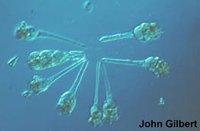 (Source: Biodiversity Institute of Ontario)
(Source: Biodiversity Institute of Ontario) Rotifers reproduce both sexually and parthenogenetically. If they reproduce sexually, the males either insert sperm into the cloaca of a female, or inject sperm directly into the pseudocoelom (hypodermic impregnation). The eggs that are developed in this way produce encapsulating membranes that allow them to survive adverse conditions. Parthenogenesis is common in rotifers that live in freshwater habitats that undergo severe seasonal changes. In favorable conditions females produce mitotic eggs which do not need to be fertilized. If these eggs are exposed to changing day lengths, temperature changes, decreasing food resources, or increasing population density they develop into females that produce haploid eggs. These haploid eggs develop into haploid males, or can be fertilized by haploid males to produce zygotes encased in thick walls that are resistant to low temperature, desiccation, and other adverse conditions. These zygotes will themselves hatch into amictic females when favourable environmental conditions return. Most rotifers are oviparous, but some are ovoviviparous.
Ecology
Most rotifers are found in freshwater, but they also occur in marine and moist terrestrial habitats. In freshwater they are often found at densities of over 5000 individuals per litre. Most rotifers are planktonic, but sessile forms are not uncommon.
 (Source: Biodiversity Institute of Ontario) (Source: Biodiversity Institute of Ontario) |
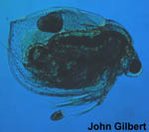 (Source: Biodiversity Institute of Ontario) (Source: Biodiversity Institute of Ontario) |
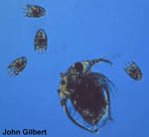 (Source: Biodiversity Institute of Ontario) (Source: Biodiversity Institute of Ontario) |
Rotifers mostly feed on the small particles and organisms that are brought into the mouth by the beating of the cilia in the corona. Some rotifers are raptorial and capture prey with the jaws in their mastax. After food is captured, the mastax grinds the food into smaller pieces before it passes into the rest of the digestive system.
Rotifers are an important food source for other rotifers, copepods, malacostracans, insect larvae and fish. Some rotifers have various spines that help protect them from predators.
Idiosyncratic Inverts
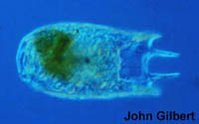 (Source: Biodiversity Institute of Ontario) (Source: Biodiversity Institute of Ontario) |
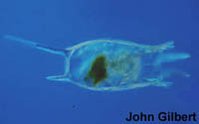 (Source: Biodiversity Institute of Ontario) (Source: Biodiversity Institute of Ontario) |
Rotifers are born with a set number of cells and they can't develop any more cells. Most females only have about 900 cells!
Rotifers exhibit developmental polymorphism which means that under different ecological conditions they develop into different forms.